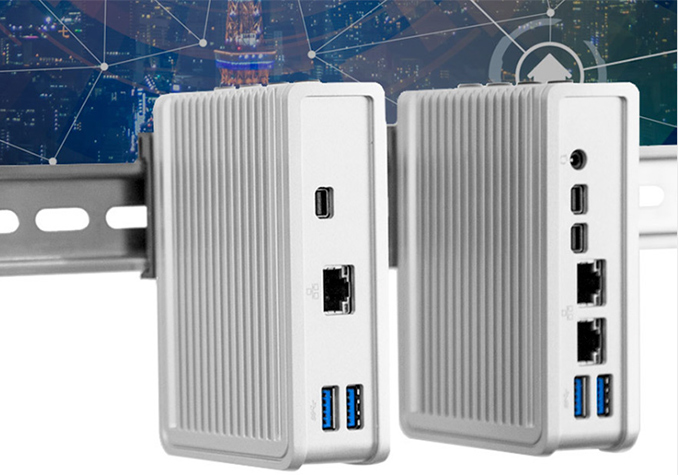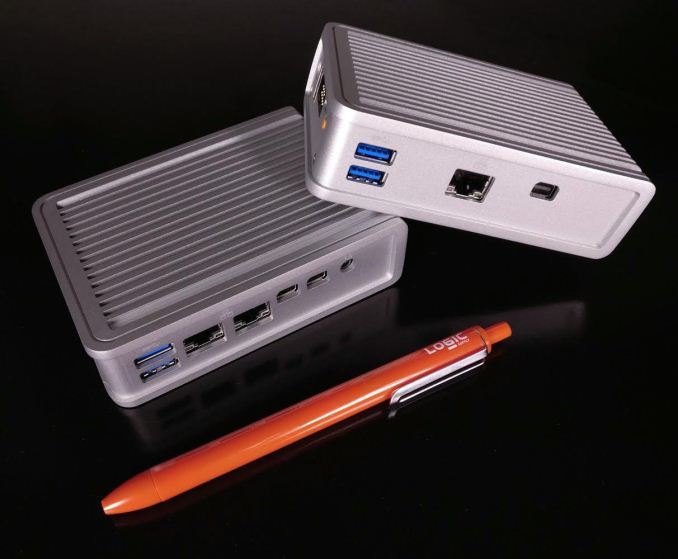Logic Supply Unveils Fanless Wallet-Sized CL200 UCFF PCs: 4G-Ready, up to 9 I/O Ports
by Anton Shilov on March 22, 2018 7:00 PM EST- Posted in
- Desktop
- Systems
- Intel
- Celeron
- Industrial PC
- Logic Supply
- Apollo Lake
- CL200

Logic Supply this week introduced its new series of ultra-compact form-factor (UCFF) PCs that boast a fanless design as well as rich connectivity via an optional 4G modem. The Logic Supply CL200-series systems are designed primarily for applications that do not require performance of modern PCs, but benefit from their versatility when it comes to software compatibility and connectivity.
As computer usage expands across all industries, demand for specialized systems is growing. One particular area of growth are miniature special-purpose systems designed for various emerging workloads that did not exist a couple of years ago. Logic Supply’s CL200-series UCFF PCs clearly fit into this category. Measuring 83×116×34 mm, these systems little bigger than a large wallet. They come in sealed Hardshell chassis designed to enable fanless cooling and keep airborne debris out, which is important for target applications, such as digital signage, data acquisition, automation, network gateway, and others.
The Logic Supply CL200-series industrial PCs are based on Intel’s Celeron N3350 SoC (2C/2T, 1.1 – 2.4 GHz, HD Graphics 500, 6 W), not exactly a high-performance processor, but should be enough for tasks that do not need a lot of compute horsepower (at least from Logic Supply’s point of view). The manufacturer will ship CL200 two base configurations: the entry-level CL200 and the more advanced CL210. The CL200 is equipped with 1 GB of LPDDR4 and 8 GB of eMMC storage, it has two USB 3.0 connectors (+ one USB 2.0), a GbE port, an RS-232 box header, a microSD slot, and a mini DisplayPort. By contrast, the CL210 is outfitted with 2 GB of RAM, 32 GB of eMMC storage, two USB 3.0 (+ one USB 2.0), two GbE, one 3.5-mm TRRS audio jack, an RS-232 box header, a microSD slot, and two mDP connectors. Given the storage constraints, the CL200 will only ship with Linux 16.04, whereas the CL210 will be offered with either Windows 10 or Linux 16.04. When it comes to wireless connectivity, the CL200-series PCs will support Wi-Fi, Bluetooth, and 4G/LTE, but actual configurations will have to be built-to-order due to different requirements (some customers may prefer lack of any wireless connectivity due to security concerns, for example).
| Preliminary Specifications of Logic Supply's CL200 Industrial PCs | ||||
| CL200 | CL210 | |||
| CPU | Celeron N3350 SoC 2 cores/2 threads 1.1 – 2.4 GHz 2 MB L2 6 W |
|||
| iGPU | HD 500, 12 EUs at 200 - 650 MHz | |||
| Memory | 1 GB LPDDR4 | 2 GB LPDDR4 | ||
| Storage | eMMC | 8 GB eMMC | 32 GB eMMC | |
| Other | microSD | |||
| Wireless | optional 802.11 Wi-Fi + BT 4.2 + 4G/LTE | |||
| Ethernet | 1 × GbE with RJ45 connector | 2 × GbE with RJ45 connector | ||
| Display Outputs | Mini DisplayPort 1.2 | 2 × Mini DisplayPort 1.2 | ||
| Audio | mDP | 1 × TRRS connector mDP |
||
| USB | 2 × USB 3.0 Type-A on front 1 × USB 2.0 Type-A on bottom |
|||
| RS-232 | 1 × RS-232 box header on bottom | |||
| PSU | External | |||
| OS | Linux 16.04 | Windows 10 or Linux 16.04 | ||
Logic Supply’s CL200-series systems are entering a pretty saturated market niche. They are going to face competition from ECS’ Liva Z and Liva Q PCs, ZOTAC’s Pico-series computers, Intel’s own Compute Cards as well as many other products. All of the aforementioned PCs have their own peculiarities, some offer better performance, other support better connectivity, but since we are talking about computers for specialized applications, design wins of these PCs will depend on suitability for particular usage scenarios and project requirements.
The manufacturer has not announced pricing of its CL200-series industrial PCs, but only said that it would ship them this spring.
Related Reading:
- ZOTAC at CES 2018: Gemini Lake 'Credit Card' Pico PCs
- Intel Compute Card: A Universal Compute Form-Factor for Different Kinds of Devices
- Intel's Credit-Card Sized Compute Card Detailed, Shipping in August
- ECS at CES 2018: LIVA Z2, LIVA Q2 & LIVA One SoC Gemini Lake-Based UCFF PCs
- ECS Adds LIVA Q to Lineup: a 5 Oz Apollo Lake Nettop with HDMI 2.0 for Consumers
- ECS Quietly Adds PB01CF Ultra Compact PC to Lineup: a 5 Oz Apollo Lake Desktop
Source: Logic Supply












21 Comments
View All Comments
PeachNCream - Thursday, March 22, 2018 - link
Either would make for a decent little industrial box on Linux, but I'd absolutely abhor the idea of trying to cram Windows 10 into 32GB of storage. It'd end up failing to run updates without sending you jumping through hoops to clean out stuff even with few to no programs installed. I've been down that road enough times with 32GB eMMC devices to know better than to try to use one to run a Microsoft OS. That's just begging for unnecessary pain.LostWander - Thursday, March 22, 2018 - link
Just here to +1 on this. 32GB of storage for Win 10 feels fine until the next version update which is only every couple months these days.ಬುಲ್ವಿಂಕಲ್ ಜೆ ಮೂಸ್ - Thursday, March 22, 2018 - link
Windows may not have an option to stop updating but what would happen if you just block all Microsoft crap from within a firewall like Glasswire?No more updates?
PeachNCream - Thursday, March 22, 2018 - link
I'd rather just get something with more storage for Windows 10 so updates aren't a problem. Wandering around the Internet with intentionally unmitigated vulnerabilities isn't an appealing idea even with a fairly well locked down browser visiting credible websites. Maybe for one of these Logic Supply systems that could spend most or all of its time offline or in a relatively closed network performing a digital signage chore or acting as the brains in some industrial automation system it wouldn't be a big deal, but I wouldn't want to take the chance with a general purpose workstation.PeachNCream - Thursday, March 22, 2018 - link
I'd rather just get something with more storage for Windows 10 so updates aren't a problem. Wandering around the Internet with intentionally unmitigated vulnerabilities isn't an appealing idea even with a fairly well locked down browser visiting credible websites. Maybe for one of these Logic Supply systems that could spend most or all of its time offline or in a relatively closed network performing a digital signage chore or acting as the brains in some industrial automation system it wouldn't be a big deal, but I wouldn't want to take the chance with a general purpose workstation.ZeDestructor - Friday, March 23, 2018 - link
They'll almost certainly be online (and probably directly accessible, probably over straight RDP), for remote admin/troubleshooting purposes.edzieba - Friday, March 23, 2018 - link
Just use the existing SD slot (or a USB drive formatted as NTFS) when performing large OS updates. The Windows updater will copy the OS to the external drive, then slipstream the updated OS back onto the main drive. Same process as with updating from 7/8/8.1 to 10 on small drives (Windows.old folder ends up on external drive).ads295 - Friday, March 23, 2018 - link
How does one use removable media this way? I'm sure there's more to it than simply plugging in the drive when Windows is updating...close - Friday, March 23, 2018 - link
Correct. You have to plug in the (properly formatted) card *before* Windows starts updating. But other than that yeah, that's about it.I do this every 6 months with a 32GB Windows tablet. Works every time.
Death666Angel - Friday, March 23, 2018 - link
My 32GB Win10 HTPC gave me the option to use an external USB stick when performing such update tasks. But it always failed, using 4 different external devices (32GB, 64GB sick and 320/500GB 2.5" HDD). In an large enterprise environment, I doubt they will want to go that route.